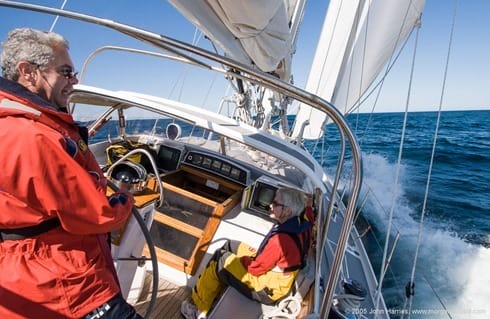 It doesn’t matter how much you read and who you talk to, your first multi-day (and night) passage at sea will be nothing like what you imagine. And your first experience of a gale at sea will be ten times as intense as you think it will be.
It doesn’t matter how much you read and who you talk to, your first multi-day (and night) passage at sea will be nothing like what you imagine. And your first experience of a gale at sea will be ten times as intense as you think it will be.
I’m not saying this to put you off, far from it, being at sea is one of the most wonderful and fulfilling experiences there is—although it’s not for everyone—but there is no way to prepare yourself and your boat for offshore voyaging if you have never done it.
Sail Offshore Before You Buy an Offshore Boat
You need to get experience offshore—and when I say offshore, I mean a passage of at least four days at sea, far from land—before you set off on your own. And even before you choose and prepare your own boat, otherwise you will make a bunch of mistakes that will cost you money and delay the day of your first cruise.
It’s also important that you get your first experiences with an experienced skipper, not another new voyager—the blind leading the blind is no fun at all and can even be dangerous.
But what if you don’t know any experienced offshore sailors? Luckily there are now several people offering offshore experience on a pay-to-play basis. I have not made a study of the options available, but I have heard good things about the options below:
- Mahina Expeditions, John Neal.
- 59°North, Andy Schell and Mia Karlsson.
- John Kretschmer Sailing.
- Morse Alpha Expeditions, Teresa and Ben Carey.
Rallies Are Not The Answer
One more thing on this subject. A rally is not in any way a substitute for experience and a well found boat, despite what the organizers may tell you.
I’m sure rallies are fun and full of comradeship. And I’m sure the organizers can do a lot to smooth the way in booking dockage and fixing bureaucracy problems ahead of time. But setting off across the ocean with a bunch of other boats does not make you safer—once you go to sea, each boat is truly alone.
In fact, I would take it further and say that rallies can actually be less safe and more stressful than going alone because of the pressure on the skippers to leave with the group, regardless of boat or crew issues that might make a delay or cancelation more prudent.
Also there is an inevitable pressure on the organizers to get the rally started on or near the planned date, which is worrying.
This last point is not theory. I have seen three rallies start in a developing weather situation that would have made me seriously consider postponing the passage even on our super-strong ocean-tested 26 ton cutter—two of those starts ended in tragedy.
The Picture
That’s my good friend James steering Morgan’s Cloud. James has sailed offshore with us for thousands of miles including five trips to and from Bermuda and a passage back from Greenland. If he ever decides to buy an offshore boat he will know exactly what boat he needs and how to equip it. However, I think that may never happen since James is a smart guy who understands all the advantages of being a dedicated member of the other people’s boat club!

It soooo nice to have nice friends with nice boats 🙂
Hey B….
Ditto!
John,
Once again, you are bang on with your comments regarding one’s first offshore passage, the benefits of gaining experience with seasoned skipper and you are especially on target regarding rallies. I couldn’t agree more.
Sid
Hi Sid,
Thanks for the confirmation. I know that the point about rallies will not be a popular one with many people, but it needed to be said.
John,
Excellent advice, as always. I can heartily second your endorsement of John and Amanda Swan Neal’s Mahina Adventures. Before taking off on my own boat, I sailed with them from Fiji to New Zealand. A great trip and a great education.
Alan
Hi Alan,
Thanks for the first hand information, always the best kind.
Once again John, you are right on, especially with regard to rallies and John and Amanda. I third the endorsement of Mahina Tiari. We met John back in 1988 when we were all cruising the South Pacific. He is a super nice guy, warm and friendly with a good sense of humor and an excellent teacher. One other thing that I would add is that before anyone leave on their first offshore passage, they should practice heaving-to. When you get that first gale, you will feel so much more comfortable and confident if you have practiced heaving-to. And remember that when in doubt, reduce sail. The first time you think about it is when you should shorten sail. An interesting observation on my part is that in the book about the Queen’s Day Storm during a rally from New Zealand to Fiji when many boats were lost, no boat that hove-to or lay to the wind with a sea anchor suffered much damage or were lost. The tragedies happened to those who tried to keep pushing on in the face of the storm.
Hi Scott,
Thanks for the confirmation. And I entirely agree with you about the benefits of being able to heave-to. Not only is it a good storm survival technique, it is also great for just taking a rest or burning off time to avoid a night approach. We have a full chapter on how to set up boats to heave-to.
On sea anchors, although we used to own one, I think that the Jordan Series Drogue is now a much better and safer alternative, at least for mono-hulls. More on the JSD and how to set up to safely deploy and retrieve here.
I think I baffled the broker who sold us our steel cutter when, during a light-air sea trial, I suggested we heave-to. “In this wind, in Lake Ontario?”
Apparently, one other guy had said this during his entire career, during the sea trial of either an Alberg 35 or 37. While I imagine that most of the readers here have done COB practice, heaving to practice, quick-stops and arcana like backing down under sail or sailing into a dock slip, this is, to my knowledge, not remotely common among today’s Pleasure Craft Operators.
But they are skills you can pick up sailing with other people.
By the way, the steel cutter heaves to quite well, a lot better than our fibreglass, fin-keeled IOR-style sloop.
It’s great to get the experience with a seasoned skipper but it still doesn’t really prepare you for an important psychological side of skippering your own boat – being solely responsible for the decision making. Something which we don’t face so much in everyday life in modern society.
I think time with an experienced skipper offshore is useful for seeing how the boat is prepared and handled but usually that skipper isn’t telling you what is going on inside his head – and that constant decision making process is a very interesting and important part of skippering (coastal or offshore).
I do think it is useful and important to build up to going offshore by making increasingly long/demanding passages skippering your own boat – first an overnight coastal passage (say cross Channel or X Thames estuary, then a weeks cruise with a series of overnighters (down/up Channel for example, with maybe a couple of full days, nights continuously at sea). At each stage as you push the boundaries of your experience wider you should know when/if you and the boat are ready for more. I’m always in awe of people who buy a boat and just set off on a major voyage with no experience at all. Sometimes it seems to work out, sometimes not – but it looks as if it makes for an interesting/intense time!
I still have some great memories of my first cross N Sea trip as skipper from Holland up to London and back – but there are a lot of things I would do differently, mostly boat prep rather than actually during the crossing, if I made that trip now.
“Experience is merely the name men gave to their mistakes.”
Hi Robbie,
I entirely agree. In fact I have written a long piece on my own evolution as a skipper, which, by the way, continues to this day. In fact, in my tip #7 in the post that started this series, I advised that the new cruiser take a step by step approach.
I totally agree with Robbie H that a step by step approach is a sound idee. For the first longer passage (including overnighter etc) I do advise (as you do, John) to first experience this with a seasoned skipper. You just cannot predict how you will function on the longer stretch, especially if the weather deteriorates. And as a skipper (even a first time) you are in the end responsible for the lives of your crew. So this is not to be taken lightly!
Erik
The first time I was on a sailboat not tied to a dock was when we did the sea trial the day I bought the 37 footer. The second time was the next day when I set sail from Bradenton Florida bound for Galveston, Tx. Went straight across in 5 days. Learned a little more about sailing than I’d gotten from books.
Would I do it that way again? Probably not. But I followed up with many deliveries and some cruising.